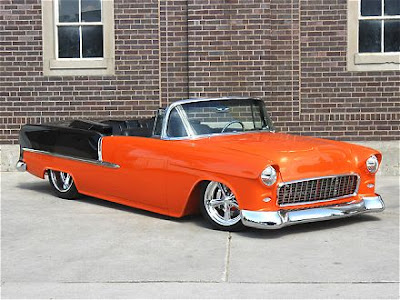The lost art of keeping tradition...
Skeeter’s Performance Fabrication builds a nitrous-fed shoebox that’s actually a time machine
Within the hot rod market, we usually run across an awesome, Tri-Five Chevy that captures the “Americana” corner of our hearts, the part that craves everything nostalgia. Here in our great country where 55-57 era shoeboxes always have a huge part in the landscape, there are a great many builders who either do custom conversions that leave us in awe, or else clean restorations that resurrect the showroom quality that was intended back when the car(s) was new. Every once in a while, however, an automotive writer like myself comes across that “bad boy” hot rod with slicks and centerlines that brings out the “bad boy” in them.
For me, this is what the pro-streeted, ’57 Chevy post built by Skeeter’s Performance Fabrication does; it brings out that little “greaser” who is buried deep inside of my psyche. It makes me want to run back to the days of Van Nuys bench racing and “Super Shops.” Where Skeeter’s has been successful is in the maintaining of old-school, hot rod tech. For example, Skeeter’s ’57 does not use anything that is high-tech or over-the-top to make brute power. Where a lot of modern hot rodding has shifted in the direction of LS heads and EFI, Skeeter stays true to the backyard ethic of engine-building with a 468-cube big block (454 punched .030 over). The motor is built stout with a nice set of Brodix BB2 Plus heads and 4-bolt mains. The bottom-end consists of a forged, 4.00” stroke crank with an ATI balancer, and the pistons and con rods are aluminum pieces from Childs & Albert.
The valvetrain of this over-bored big block is tapped by a Comp Cams, .735” lift, 313/330 duration roller cam and lifters. The push rods are also from Comp, and the rocker arms are Crower, stainless roller rockers. Topping off the whole platform is a Holley 1150 CFM Dominator Series carb with a Brodix, HV2001 intake.
As if Skeeter’s Performance hasn’t done enough to bring back the lost art of rat-rodding, their bad-boy ’57 gains most of its competitive edge from NOS’ 4500 Plate with Pro Fogger solenoids and a 15-lb. bottle. This unbeatable combination of Brodix heads and intake, Comp cam and NOS make for a screamin’ street car that runs an easy 9.83 ET at 130 mph on 110-octane fuel with nitrous; without the NOS, the car runs 10.51 @ 127.
Transferring all of this power is a Turbo 400 trans built by U. S. Speed Research. At the rear is a set of 4:56 gears from Richmond, backed-up by a Dana 60 rear-end. Launching the 3600-pound sleeper into the next dimension is a 5500-RPM stall from Neil Chance.
There’s always a certain sense of sentimental value when it comes to the Tri-Five Chevys; almost everyone who thinks “American” thinks “Chevy Bel Air.” But there is also a certain sentiment that comes with old-school built drag cars, because how often in our Web-based world do you see even the most prolific hot rod builders build super-fast sleepers with tunnel ram scoops and Centerlines? In the case of Skeeter’s Performance’s nitrous-shot, roller motor-powered ’57 sedan, these once common elements of hot rod mania have been brought back from the dead in a way that only a certain kind of “Shadetree Mechanic” can successfully do.
With some cars, it’s the little things or features that count the most; the subtlety of the ’57 Chev’s Centerline wheels and Saturday afternoon drag race hood are what make--ironically enough--the car remarkable. But what’s most remarkable about Skeeter’s ’57 are the thoughts and memories that it evokes. For myself, the car evokes a feeling of, “Hey, I’m the ‘Fonz’ and this is ‘Fonzie’s’ car, so don’t be messin’ with it!” Growing up in the San Fernando Valley around a lot of much-older people who told these kinds of stories from Van Nuys Blvd and the “Old Road,” that was exactly the feeling you got, that there was a certain license of “machismo” that came with owning such a car as a ’57 with a roller-cammed big block on NOS. These cars represented, for me at least, a certain edge or stigma that a lot of guys were able to achieve, while a lot of other guys like myself were not. One thing that could be said about a lot of the suburbs’ toughest is that they either drove a fast car or rode a motorcycle; for many of these, they drove ’57 Chevys with roller-cammed, nitrous-injected big blocks.
- Sal Alaimo Jr., B. A. (7/5/11)
S. J. A.







